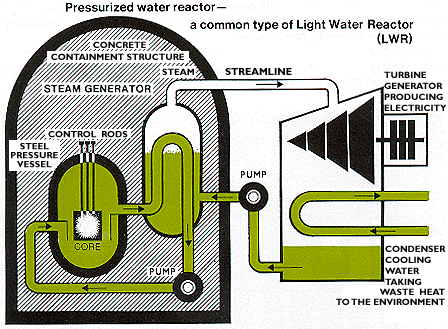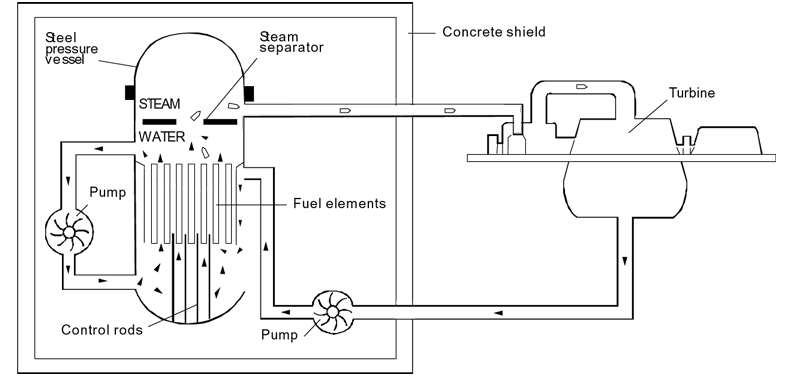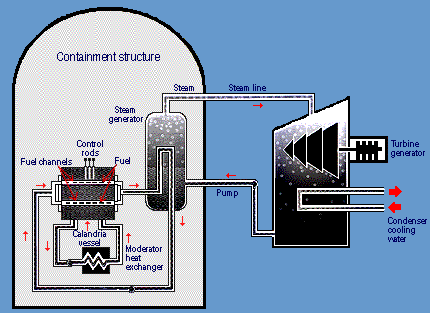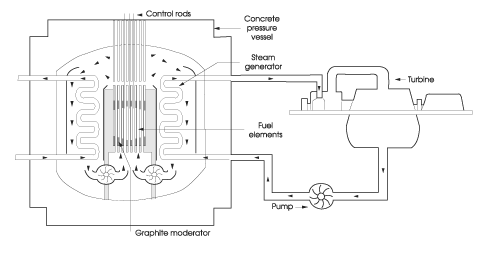
Legal Disclaimer Legal information enclosed. Please read.
A couple of very good gifs of nuclear reactors I want to share
Briefing Paper # 64
October 2005
A nuclear reactor produces and controls the release of energy from splitting the atoms of certain elements. In a nuclear power reactor, the energy released is used as heat to make steam to generate electricity. (In a research reactor the main purpose is to utilise the actual neutrons produced in the core. In most naval reactors, steam drives a turbine directly for propulsion.)
The principles for using nuclear power to produce electricity are the same for most types of reactor. The energy released from continuous fission of the atoms of the fuel is harnessed as heat in either a gas or water, and is used to produce steam. The steam is used to drive the turbines which produce electricity (as in most fossil fuel plants).
There are several components common to most types of reactors:
Fuel. Usually pellets of uranium oxide (UO2) arranged in tubes to form fuel rods. The rods are arranged into fuel assemblies in the reactor core.
Moderator. This is material which slows down the neutrons released from fission so that they cause more fission. It is usually water, but may be heavy water or graphite.
Control rods. These are made with neutron-absorbing material such as cadmium, hafnium or boron, and are inserted or withdrawn from the core to control the rate of reaction, or to halt it. (Secondary shutdown systems involve adding other neutron absorbers, usually as a fluid, to the system.)
Coolant. A liquid or gas circulating through the core so as to transfer the heat from it. In light water reactors the moderator functions also as coolant.
Pressure vessel or pressure tubes. Usually a robust steel vessel containing the reactor core and moderator/coolant, but it may be a series of tubes holding the fuel and conveying the coolant through the moderator.
Steam generator. Part of the cooling system where the heat from the reactor is used to make steam for the turbine.
Containment. The structure around the reactor core which is designed to protect it from outside intrusion and to protect those outside from the effects of radiation in case of any malfunction inside. It is typically a metre-thick concrete and steel structure.
There are several different types of reactors as indicated in the following table.
| Nuclear power plants in commercial operation | ||||||
| Reactor type | Main Countries | Number | GWe | Fuel | Coolant | Moderator |
|
Pressurised Water Reactor (PWR) |
US, France, Japan, Russia |
268 |
249 |
enriched UO2 |
water |
water |
|
Boiling Water Reactor (BWR) |
US, Japan, Sweden |
94 |
85 |
enriched UO2 |
water |
water |
|
Gas-cooled Reactor (Magnox & AGR) |
UK |
23 |
12 |
natural
U (metal), |
CO2 |
graphite |
|
Pressurised Heavy Water Reactor 'CANDU' (PHWR) |
Canada |
40 |
22 |
natural UO2 |
heavy water |
heavy water |
|
Light Water Graphite Reactor (RBMK) |
Russia |
12 |
12 |
enriched UO2 |
water |
graphite |
|
Fast Neutron Reactor (FBR) |
Japan, France, Russia |
4 |
1 |
PuO2 and UO2 |
liquid sodium |
none |
|
TOTAL |
441 |
381 |
||||
GWe
= capacity in thousands of megawatts.
Source: Nuclear Engineering International Handbook 2005
For reactors under construction: see paper Plans for New reactors Worldwide
Most reactors need to be shut down for refuelling, so that the pressure vessel can be opened up. In this case refuelling is at intervals of 1-2 years, when a quarter to a third of the fuel assemblies are replaced with fresh ones. The CANDU and RBMK types have pressure tubes (rather than a pressure vessel enclosing the reactor core) and can be refuelled under load by disconnecting individual pressure tubes.
If graphite or heavy water is used as moderator, it is possible to run a power reactor on natural instead of enriched uranium. Natural uranium has the same elemental composition as when it was mined (0.7% U-235, over 99.2% U-238), enriched uranium has had the proportion of the fissile isotope (U-235) increased by a process called enrichment, commonly to 3.5 - 5.0%. In this case the moderator can be ordinary water, and such reactors are collectively called light water reactors. Because the light water absorbs neutrons as well as slowing them, it is less efficient as a moderator than heavy water or graphite.
Practically all fuel is ceramic uranium oxide (UO2 with a melting point of 2800°C) and most is enriched. The fuel pellets (usually about 1 cm diameter and 1.5 cm long) are typically arranged in a long zirconium alloy (zircaloy) tube to form a fuel rod, the zirconium being hard, corrosion-resistant and permeable to neutrons.* Numerous rods form a fuel assembly, which is an open lattice and can be lifted into and out of the reactor core. In the most common reactors these are about 3.5 metres long.
*Zirconium is an important mineral for nuclear power, where it finds its main use. It is therefore subject to controls on trading. It is normally contaminated with hafnium, a neutron absorber, so very pure 'nuclear grade' Zr is used to make the zircaloy, which is about 98% Zr plus tin, iron, chromium and sometimes nickel to enhance its strength.
Burnable poisons are often used (especially in BWR) in fuel or coolant to even out the performance of the reactor over time from fresh fuel being loaded to refuelling. These are neutron absorbers which decay under neutron exposure, compensating for the progressive build up of neutron absorbers in the fuel as it is burned. The best known is gadolinium, which is a vital ingredient of fuel in naval reactors where installing fresh fuel is very inconvenient, so reactors are designed to run more than a decade between refuellings .

Pressurised Water Reactor (PWR)
This is the most common type, with over 230 in use for power generation and a further several hundred in naval propulsion. The design originated as a submarine power plant. It uses ordinary water as both coolant and moderator. The design is distinguished by having a primary cooling circuit which flows through the core of the reactor under very high pressure, and a secondary circuit in which steam is generated to drive the turbine.
A PWR has fuel assemblies of 200-300 rods each, arranged vertically in the core, and a large reactor would have about 150-250 fuel assemblies with 80-100 tonnes of uranium.
Water in the reactor core reaches about 325�C, hence it must be kept under about 150 times atmospheric pressure to prevent it boiling. Pressure is maintained by steam in a pressuriser (see diagram). In the primary cooling circuit the water is also the moderator, and if any of it turned to steam the fission reaction would slow down. This negative feedback effect is one of the safety features of the type. The secondary shutdown system involves adding boron to the primary circuit.
The secondary circuit is under less pressure and the water here boils in the heat exchangers which are thus steam generators. The steam drives the turbine to produce electricity, and is then condensed and returned to the heat exchangers in contact with the primary circuit.
Boiling Water Reactor (BWR).
This design (diagram next page) has many similarities to the PWR, except that there is only a single circuit in which the water is at lower pressure (about 75 times atmospheric pressure) so that it boils in the core at about 285�C. The reactor is designed to operate with 12-15% of the water in the top part of the core as steam, and hence with less moderating effect and thus efficiency there.
The steam passes through drier plates (steam separators) above the core and then directly to the turbines, which are thus part of the reactor circuit. Since the water around the core of a reactor is always contaminated with traces of radionuclides, it means that the turbine must be shielded and radiological protection provided during maintenance. The cost of this tends to balance the savings due to the simpler design. Most of the radioactivity in the water is very short-lived*, so the turbine hall can be entered soon after the reactor is shut down.
* mostly N-16, with a 7 second half-life
A BWR fuel assembly comprises 90-100 fuel rods, and there are up to 750 assemblies in a reactor core, holding up to 140 tonnes of uranium. The secondary control system involves restricting water flow through the core so that steam in the top part means moderation is reduced.

BWR
Pressurised Heavy Water Reactor (PHWR or CANDU).
The CANDU reactor design has been developed since the 1950s in Canada. It uses natural uranium (0.7% U-235) oxide as fuel, hence needs a more efficient moderator, in this case heavy water (D2O).**
** with the CANDU system, the moderator is enriched (ie water) rather than the fuel, - a cost trade-off.
The moderator is in a large tank called a calandria, penetrated by several hundred horizontal pressure tubes which form channels for the fuel, cooled by a flow of heavy water under high pressure in the primary cooling circuit, reaching 290�C. As in the PWR, the primary coolant generates steam in a secondary circuit to drive the turbines. The pressure tube design means that the reactor can be refuelled progressively without shutting down, by isolating individual pressure tubes from the cooling circuit.

A CANDU fuel assembly consists of a bundle of 37 half metre long fuel rods (ceramic fuel pellets in zircaloy tubes) plus a support structure, with 12 bundles lying end to end in a fuel channel. Control rods penetrate the calandria vertically, and a secondary shutdown system involves adding gadolinium to the moderator. The heavy water moderator circulating through the body of the calandria vessel also yields some heat (though this circuit is not shown on the diagram above).
Advanced Gas-cooled Reactor (AGR)
These are the second generation of British gas-cooled reactors, using graphite moderator and carbon dioxide as coolant. The fuel is uranium oxide pellets, enriched to 2.5-3.5%, in stainless steel tubes. The carbon dioxide circulates through the core, reaching 650�C and then past steam generator tubes outside it, but still inside the concrete and steel pressure vessel. Control rods penetrate the moderator and a secondary shutdown system involves injecting nitrogen to the coolant.

The AGR was developed from the Magnox reactor, also graphite moderated and CO2 cooled, and a number of these are still operating in UK. They use natural uranium fuel in metal form.
Light water graphite-moderated reactor (RBMK).
This is a Soviet design, developed from plutonium production reactors. It employs long (7 metre) vertical pressure tubes running through graphite moderator, and is cooled by water, which is allowed to boil in the core at 290°C, much as in a BWR. Fuel is low-enriched uranium oxide made up into fuel assemblies 3.5 metres long. With moderation largely due to the fixed graphite, excess boiling simply reduces the cooling and neutron absorbtion without inhibiting the fission reaction, and a positive feedback problem can arise.
Advanced reactorsSeveral generations of reactors are commonly distinguished. Generation I reactors were developed in 1950-60s and relatively few are still running today. They mostly used natural uranium fuel and used graphite as moderator. Generation II reactors are typified by the present US fleet and most in operation elsewhere. They typically use enriched uranium fuel and are mostly cooled and moderated by water. Generation III are the Advanced Reactors, the first three of which are in operation in Japan and others are under construction or ready to be ordered. They are developments of the second generation with enhanced safety.
Generation IV designs are still on the drawing board and will not be operational before 2020 at the earliest, probably later. They will tend to have closed fuel cycles and burn the long-lived actinides now forming part of spent fuel, so that fission products are the only high-level waste. Many will be fast neutron reactors.
More than a dozen (Generation III) advanced reactor designs are in various stages of development. Some are evolutionary from the PWR, BWR and CANDU designs above, some are more radical departures. The former include the Advanced Boiling Water Reactor, two of which are now operating with others under construction. The best-known radical new design is the Pebble Bed Modular Reactor, using helium as coolant, at very high temperature, to drive a turbine directly.
Considering the closed fuel cycle, Generation 1-3 reactors recycle plutonium (and possibly uranium), while Generation IV are expected to have full actinide recycle.Fast neutron reactors
Some reactors (only one in commercial service) do not have a moderator and utilise fast neutrons, generating power from plutonium while making more of it from the U-238 isotope in or around the fuel. While they get more than 60 times as much energy from the original uranium compared with the normal reactors, they are expensive to build and await resource scarcity to come into their own. See also Advanced Reactors and Small Reactors papers.
Primitive reactors The world's oldest known nuclear reactors operated at what is now Oklo in Gabon, West Africa. About 2 billion years ago, at least 17 natural nuclear reactors achieved criticality in a rich deposit of uranium ore. Each operated at about 20 kW thermal. At that time the concentration of U-235 in all natural uranium was 3.7 percent instead of 0.7 percent as at present. (U-235 decays much faster than U-238, whose half-life is about the same as the age of the Earth.) These natural chain reactions, started spontaneously by the presence of water acting as a moderator, continued for about 2 million years before finally dying away.
During this long reaction period about 5.4 tonnes of fission products as well as 1.5 tonnes of plutonium together with other transuranic elements were generated in the orebody. The initial radioactive products have long since decayed into stable elements but close study of the amount and location of these has shown that there was little movement of radioactive wastes during and after the nuclear reactions. Plutonium and the other transuranics remained immobile.
Sources:
Wilson,
P.D., 1996, The Nuclear Fuel Cycle, OUP.
http://www.uic.com.au/nip64.htm